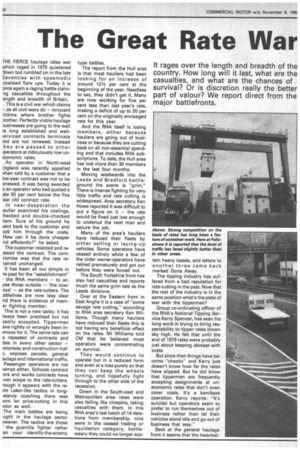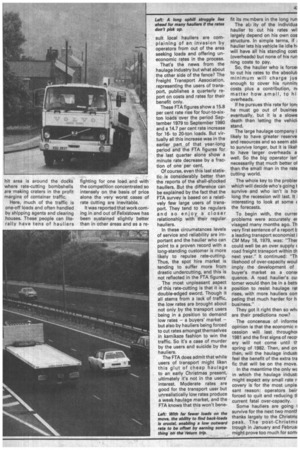The Great Rate War
Page 44

Page 45

If you've noticed an error in this article please click here to report it so we can fix it.
THE FIERCE haulage rates war tvhich raged in 1975 quietened iown but rumbled on in the late Seventies with spasmodic ocalised flare ups. Today it is Dnce again a raging battle claimng casualties throughout the ength and breadth of Britain. This is a civil war which claims as all civil wars do — innocent tictims where brother fights Drother. Perfectly viable haulage )usinesses are going to the wall is long established and well;erviced contracts terminate Ind are not renewed. Instead hey are passed to other merators at ridiculously low untconomic rates.
An operator in North-west :ngland was recently appalled vhen told by a customer that a ive-year contract was not to be enewed. It was being awarded o an operator who had quoted a ate 50 per cent below the five :ear old contract rate.
In near-desperation the iaulier examined his costings, hecked and double-checked hem. Sure of his ground he gent back to the customer and Dok him through the costs. How can it be done cheaper nd efficiently?" he asked. The customer relented and reewed the contract. The comromise was that the rate re-mined unchanged.
It has been all too simple in ie past for the "establishment" the RHA members — to acuse those outside — the cowoys' — as the rate-cutters. The attlelines are now less clear nd there is evidence of memer fighting member.
This is not a new tactic; it has lways been practised but not mdily accepted. Tippermen ave rightly or wrongly been in'mous for it. The same tale can e repeated of contracts and Fres in every other sector — iotorway and construction traf::, express parcels, general aulage and international traffic. Passenger operators are not (empt either. Schools contract ork and works contracts have ven scope to the rate-cutters. hough it appears with the rent Laker-like tactics in longstance coaching there was iom for price-cutting in this :ctor as well.
The main battles are being ught in the haulage sector Dwever. The tactics are those the guerrilla fighter rather an your identify-the-enemy type battles.
The report from the Hull area is that most hauliers had been looking for an increase of around 121/2 per cent at the beginning of the year. Needless to say, they didn't get it. Many are now working for five per cent less than last year's rate, making a deficit of up to 20 per cent on the originally envisaged rate for this year.
And the RHA itself is losing members, either because hauliers are going out of business or because they are cutting back on all non-essential spending and that includes RHA subscriptions. To date, the Hull area has lost more than 30 members in the last four months.
Moving westwards into the Leeds and Bradford battleground the scene is "grim." There is intense fighting for very little traffic and rate cutting is widespread. Area secretary Ken Howe reported it was difficult to put a figure on it — the rate would be fixed just low enough to undercut the next man and secure the job.
Many of the area's hauliers have reduced their fleets by either selling or laying-up vehicles. Some operators have ceased entirely while a few of the older owner-operators have retired prematurely and got out before they were forced out.
The South Yorkshire front has also had casualties and reports much the same grim tale as the Leeds divisions.
Over at the Eastern front in East Anglia it is a case of "some savage rate cutting," according to RHA area secretary Ken Williams. Though many hauliers have reduced their fleets this is not having any beneficial effect on the rates. Mr Williams told CM that he believed most operators were concentrating on survival.
They would continue to operate but in a reduced form and even at a loss purely so that they can keep the wheels turning, and hopefully fight through to the other side of the recession.
Down in the South-east and Metropolitan area rates were also falling like ninepins, taking casualties with them. In this RHA area's last batch of 14 deletions from membership, nine were in the ceased trading or liquidation category, battleweary they could no longer sus tam n heavy losses, and letters to another three came back marked Gone Away.
The tipping industry has suffered from a bad reputation for rate-cutting in the past. Now that the rest of the industry is in the same position what's the state of war with the tippermen?
Group co-ordinating officer of the RHA's National Tipping Service Kerry Spencer, has seen his long work in trying to bring respectability to tipper rates blown sky high. He felt that until the end of 1979 rates were probably just about keeping abreast with costs.
But since then things have become "chaotic" and Kerry just doesn't know how far the rates have slipped. But he did know that tippermen are frequently accepting assignments at uneconomic rates that don't even cover costs. It's a kamikaze operation. Kerry reports: "It's suicidal but operators seem to prefer to run themselves out of business rather than let their vehicles stand idle and go out of business that way."
Back at the general haulage front it seems that the heaviest hit area is around the docks where rate-cutting bombshells are making craters in the profit margins of container traffic.
Here, much of the traffic is one-off loads and often handled by shipping agents and clearing houses. These people can literally have tens of hauliers fighting for one load and with the competition concentrated so intensely on the basis of price alone the very worst cases of rate cutting are inevitable.
It was reported that work coming in and out of Felixstowe has been sustained slightly better than in other areas and as a re suit local hauliers are complaining of an invasion by operators from out of the area seeking loads and offering uneconomic rates in the process. That's the news from the haulage industry but what about the other side of the fence? The Freight Transport Association, representing the users of transport, publishes a quarterly report on costs and rates for their benefit only.
These FTA figures show a 15.8 per cent rate rise for four-to-sixton loads over the period September 1979 to September 1980 and a 14.7 per cent rate increase for 16to 20-ton loads. But virtually all this increase was in the earlier part of that year-long period and the FTA figures for the last quarter alone show a minute rate decrease by a fraction of one per cent.
Of course, even this last statistic is considerably better than the reports of the shell-shocked hauliers. But the difference can be explained by the fact that the FTA survey is based on a relatively few large users of transport. They tend to be regulars and so enjoy a closer relationship with their regular hauliers.
In these circumstances levels of service and reliability are important and the haulier who can point to a proven record with a long-standing customer is more likely to repulse rate-cutting. Thus, the spot hire market is tending to suffer more from drastic undercutting, and this is not reflected in the FTA figures.
The most unpleasant aspect of this rate-cutting is that it is a double-edged sword. Though it all stems from a lack of traffic, the low rates are brought about not only by the transport users being in a position to demand low rates — a buyers' market — but also by hauliers being forced to cut rates amongst themselves in kamikaze fashion to win the traffic. So it's a case of murder by the users and suicide by the hauliers.
The FTA does admit that while users of transport might liken this glut of cheap haulage to an early Christmas present, ultimately it's not in the users' interest. Moderate rates are good for the transport user but unrealistically low rates produce a weak haulage market, and the FTA knows that this won't bene
fit its ME mbers in the long run
The at)! ity of the individua haulier to cut his rates wil largely depend on his own cos structure. In simple terms, if ; haulier lets his vehicle lie idle hi will have all his standing cost (overheads) but none of his run ning costs to pay.
So, the haulier who is forces to cut his rates to the absolut minimum will charge jus enough to cover his runnini costs plus a contribution, ni matter how small, to hi overheads.
If he pursues this rate for loni he must go out of busines eventually, but it is a slowe death than letting the vehicli stand.
The large haulage company i likely to have greater reserve and resources and so seem abli to survive longer, but it is likel, to have larger overheads a well. So the big operator isn' necessarily that much better of than the small man in the rate cutting world.
The whole key to the probler which will decide who's going t survive and who isn't is hos long the recession will last. It i interesting to look at some c the forecasts.
To begin with, the currer problems were accurately er visaged many months ago. Th very first sentence of a report b a leading transport economist i CM May 18, 1979, was: "Ther could well be an over supply ( road freight transport within th next year." It continued: "Th likehood of over-capacity woul imply the development of buyer's market as a const quence. A road haulier's cu: tamer would then be in a bettt position to resist haulage rat rises, with more hauliers con peting that much harder for h business."
They got it right then so wh; are their predictions now?
The concensus of informe opinion is that the economic ri cession will last throughoi 1981 and the first signs of recos ery will not come until th spring of 1982. Then, and on then, will the haulage industi feel the benefit of the extra tra fic that will be on the move.
In the meantime the only WE in which the haulage industi might expect any small rate r covery is for the most unple, sant reason: operators beir forced to quit and reducing ti current fatal over-capacity.
Some hauliers are going I survive for the next two rnontF thanks largely to the Christrnz' peak. The post-ChristmE trough in January and Februal might prove too much for sorni




















































































































